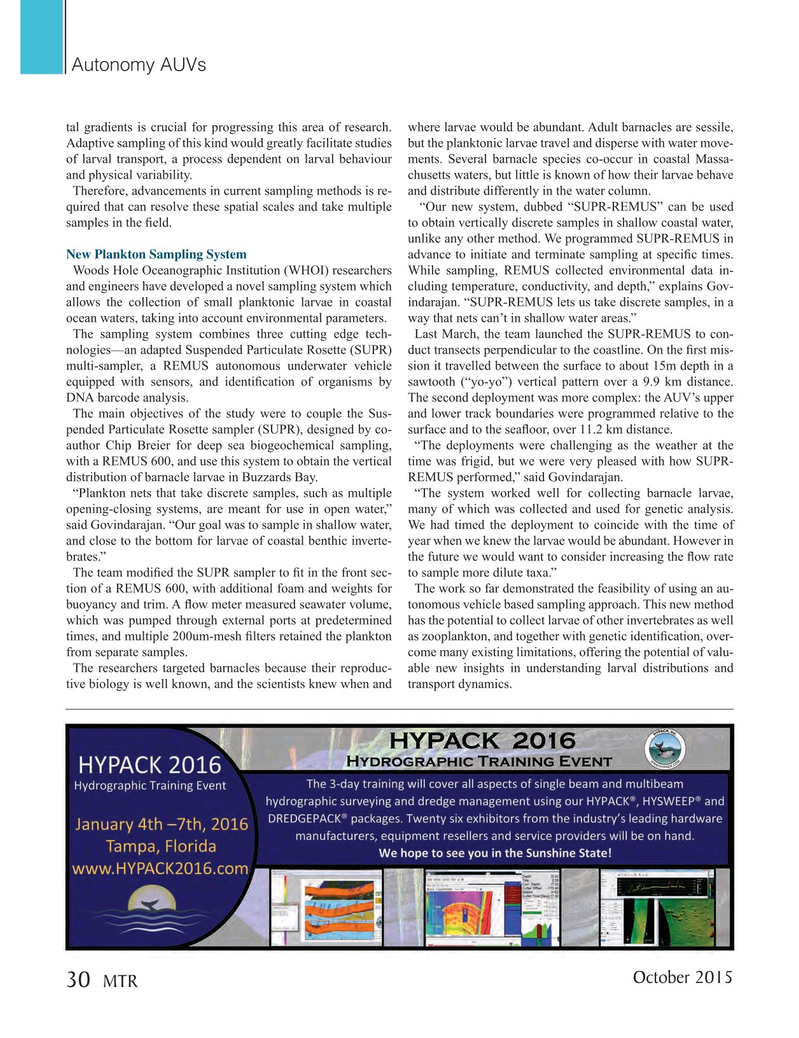
Page 30: of Marine Technology Magazine (October 2015)
AUV Operations
Read this page in Pdf, Flash or Html5 edition of October 2015 Marine Technology Magazine
Autonomy AUVs tal gradients is crucial for progressing this area of research. where larvae would be abundant. Adult barnacles are sessile,
Adaptive sampling of this kind would greatly facilitate studies but the planktonic larvae travel and disperse with water move- of larval transport, a process dependent on larval behaviour ments. Several barnacle species co-occur in coastal Massa- and physical variability. chusetts waters, but little is known of how their larvae behave
Therefore, advancements in current sampling methods is re- and distribute differently in the water column.
quired that can resolve these spatial scales and take multiple “Our new system, dubbed “SUPR-REMUS” can be used samples in the ? eld. to obtain vertically discrete samples in shallow coastal water, unlike any other method. We programmed SUPR-REMUS in
New Plankton Sampling System advance to initiate and terminate sampling at speci? c times.
Woods Hole Oceanographic Institution (WHOI) researchers While sampling, REMUS collected environmental data in- and engineers have developed a novel sampling system which cluding temperature, conductivity, and depth,” explains Gov- allows the collection of small planktonic larvae in coastal indarajan. “SUPR-REMUS lets us take discrete samples, in a ocean waters, taking into account environmental parameters. way that nets can’t in shallow water areas.”
The sampling system combines three cutting edge tech- Last March, the team launched the SUPR-REMUS to con- nologies—an adapted Suspended Particulate Rosette (SUPR) duct transects perpendicular to the coastline. On the ? rst mis- multi-sampler, a REMUS autonomous underwater vehicle sion it travelled between the surface to about 15m depth in a equipped with sensors, and identi? cation of organisms by sawtooth (“yo-yo”) vertical pattern over a 9.9 km distance.
DNA barcode analysis. The second deployment was more complex: the AUV’s upper
The main objectives of the study were to couple the Sus- and lower track boundaries were programmed relative to the pended Particulate Rosette sampler (SUPR), designed by co- surface and to the sea? oor, over 11.2 km distance.
author Chip Breier for deep sea biogeochemical sampling, “The deployments were challenging as the weather at the with a REMUS 600, and use this system to obtain the vertical time was frigid, but we were very pleased with how SUPR- distribution of barnacle larvae in Buzzards Bay. REMUS performed,” said Govindarajan.
“Plankton nets that take discrete samples, such as multiple “The system worked well for collecting barnacle larvae, opening-closing systems, are meant for use in open water,” many of which was collected and used for genetic analysis. said Govindarajan. “Our goal was to sample in shallow water, We had timed the deployment to coincide with the time of and close to the bottom for larvae of coastal benthic inverte- year when we knew the larvae would be abundant. However in brates.” the future we would want to consider increasing the ? ow rate
The team modi? ed the SUPR sampler to ? t in the front sec- to sample more dilute taxa.” tion of a REMUS 600, with additional foam and weights for The work so far demonstrated the feasibility of using an au- buoyancy and trim. A ? ow meter measured seawater volume, tonomous vehicle based sampling approach. This new method which was pumped through external ports at predetermined has the potential to collect larvae of other invertebrates as well times, and multiple 200um-mesh ? lters retained the plankton as zooplankton, and together with genetic identi? cation, over- from separate samples. come many existing limitations, offering the potential of valu-
The researchers targeted barnacles because their reproduc- able new insights in understanding larval distributions and tive biology is well known, and the scientists knew when and transport dynamics.
October 2015 30
MTR
MTR #8 (18-33).indd 30 9/29/2015 2:26:05 PM

 29
29

 31
31
